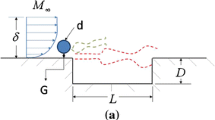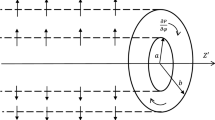Abstract
A study of the fluctuating wall pressure beneath a 2-d turbulent boundary layer was conducted in a water tunnel with Reynolds numbers, based on momentum thickness, ranging between 2,100 and 4,300. The boundary layer was perturbed with steady mild suction to assess the effect of upstream suction on the fluctuating wall pressure measured downstream of the suction slit. Wall pressure signatures were captured using a custom-fabricated piezo-ceramic array with d + values ranging between 64 and 107. Likewise, the velocity field was measured with a laser Doppler velocimeter with l + values ranging between 4.0 and 6.7 for the lowest and highest Re θ investigated. Estimates of the wall pressure spectra revealed a noticeable hydrodynamic peak that scaled reasonably well with outer variables and with an average convective speed of 75 % of the free stream velocity (based on unconditionally sampled pressure time series). Two boundary layer suction control cases were studied corresponding to suction rates of less then 30 % of the boundary layer momentum. The findings reveal how only modest amounts of suction are needed to reduce upwards 50–60 % of the hydrodynamic ridge.



















Similar content being viewed by others
Notes
Formerly Eidetics Corporation; http://www.rollinghillsresearch.com/
Specific details concerning the suction control device are discussed later in the manuscript.
References
Abraham BM, Keith WL (1998) Direct measurements of turbulent boundary layer wall pressure wavenumber-frequency spectra. J Fluids Eng 120:29–39
Agrawal A, Djenidi L, Antonia RA (2010) Near-field measurements and development of a new boundary layer over a flat plate with localized suction. Exp Fluids 48:747–762
Antonia RA, Zhu Y, Sokolov M (1995) Effect of concentrated wall suction on a turbulent boundary layer. Phys Fluids 7(10):2465–2474
Benedict LH, Tropea C, Nobach H (2000) Estimation of turbulent velocity spectra from laser doppler data. Meas Sci Technol 11:1089–1104
Butler S (1957) Current tests on laminar-boundary-layer control by suction through perforations. Aeronautical Research Council, Technical Report No. 3040,
Castillo L, George WK (2001) Similarity analysis for turbulent boundary layer with pressure gradient: outer flow. AIAA 39:41–47
Corcos GM (1963) Resolution of pressure in turbulence. JASA 35:192–199
DeGraaff DB, Eaton JK (2000) Reynolds-number scaling of the flat-plate turbulent boundary layer. J Fluid Mech 422:319–346
Dolder CN (2010) Turbulent boundary layers over receiver arrays. Master’s thesis, The University of Texas at Austin. OCLC 677138580
Dolder CN, Haberman MR, Tinney CE (2012) A laboratory scale piezoelectric array for underwater measurements of the fluctuating wall pressure beneath turbulent boundary layers. Meas Sci Technol 23:1–11
Farabee T, Casarella M (1991) Spectral features of wall pressure fluctuations beneath turbulent boundary layers. Phys Fluids 3(10):2410–2420
Farge M (1992) Wavelet transforms and their applications to turbulence. Annu Rev Fluid Mech 24:395–458
Gravante SP, Naguib AM, Wark CE, Naguib HM (1998) Characterization of the pressure fluctuations under a fully developed turbulent boundary layer. AIAA 36(10):1808–1816
Hwang YF, Bonness WK, Hambric SA (2008) Comparison of semi-empirical models for the turbulent boundary layer wall pressure spectra. J Sound Vib 319:199–217
Keith WL, Cipolla KM, Furey D (2009) Turbulent wall pressure measurements on a towed model at high reynoldsnumbers. Exp Fluids 46:181–189
Kim J, Kim K, Sung HJ (2003) Wall pressure fluctuations in a turbulent boundary layer after blowing or suction. AIAA 41(9):1697–1704
Kim KC, Adrian RJ (1999) Very large-scale motion in the outer layer. Phys Fluids 11(2):417–422
Klewicki JC, Falco RE (1990) On accurately measuring statistics associated with small-scale structure in turbulent boundary layers using hot-wire probes. J Fluid Mech 219:119–142
Klewicki JC, Priyadarshana PJA, Metzger MM (2008) Statistical structure of the fluctuating wall pressure and its in-plane gradients at high reynolds number. J Fluid Mech 609:195–220
Ko SH, Schloemer HH (1989) Calculations of turbulent boundary layer pressure fluctuations transmitted into a viscoelastic layer. JASA 85:1469–1477
Mei R (1996) Velocity fidelity of flow tracer particles. Exp Fluids 22(1):1–13
Metzger MM, Klewicki JC (2001) Scaling the near-wall axial turbulent stress in the zero pressure gradient boundary layer. Phys Fluid 13(3):692–701
Mochizuki S, Nieuwstadt FTM (1996) Reynolds-number-dependence of the maximum in the streamwise velocity fluctuations in wall turbulence. Exp Fluids 21(3):218–226
Monkewitz PA, Chauhan KA, Naguib HM (2008) Comparison of mean flow similarity laws in zero pressure gradient turbulent boundary layers. Phys Fluids 20(10):16
Musha T, Kikuchi T (2005) Adaptive signal processing for reducing nearby generated flow noise. Appl Acoust 66:1206–1217
Naguib AM, Wark CE, Juckenhöfel O (2001) Stochastic estimation and flow sources associated with surface pressure events in a turbulent boundary layer. Phys Fluids 13(9):2611–2626
Narayanan MAB (1968) An experimental study of reverse transition in a two-dimensional channel flow. J Fluid Mech 31(3):609–623
Narayanan MAB, Ramjee V (1969) On the criteria for reverse transition in a two-dimensional boundary layer flow. J Fluid Mech 35(2):225–241
Öfsterlund J, Johansson A, Nagib H, Hites M (2000) A note on the overlap region in turbulent boundary layers. Phys Fluids 12(1)
Park J, Choia H (1999) Effects of uniform blowing or suction from a spanwise slot on a turbulent boundary layer flow. Phys Fluids 11(10):3095–3105
Poggi D, Porporato A, Ridolfi L (2003) Analysis of the small-scale structure of turbulence on smooth and rough walls. Phys Fluids 15(1):35–46
Raffel M, Willert C, Wereley S, Kompenhans J (1998) Particle image velocimetry: a practical guide, 2nd edn. Springer, Berlin
Schewe G (1983) On the structure and resolution of wall-pressure fluctuations associated with turbulent boundary layer flow. J Fluid Mech 134:311–328
Schlatter P, Örlü R, Li Q, Brethouwer G, Fransson JHM, Johansson AV, Alfredsson PH, Henningson DS (2009) Turbulent boundary layers up to Rθ = 2500 studied through simulation and experiment. Phys Fluids 21:051702-1–051702-4
Schlatter PH, Örlü R (2010) Assessment of direct numerical simulation data of turbulent boundary layers. J Fluid Mech 659:116–126
Spalart PR (1988) Direct simulation of a turbulent boundary layer up to Rθ = 1410. J Fluid Mech 187:61–98
Torrence C, Compo G (1998) A practical guide to wavelet analysis. Bull Am Meteorol Soc 7(1):60–78
Villanueva MA, Tinney CE, Dolder CN, Haberman MR (2012) Flowfield and wall pressure characteristics downstream of a boundary layer suction device. 50th AIAA Aerospace Sciences Meeting and Exposition 2012-0743
White CM, Mungal MG (2008) Mechanics and prediction of turbulent drag reduction with polymer additives. Annu Rev Fluid Mech 40:235–256
Willmarth WW, Roos FW (1965) Resolution and structure of the wall pressure field beneath a turbulent boundary layer. J Fluid Mech 22(1):81–94
Willmarth WW, Wooldridge CE (1962) Measurements of the fluctuating pressure at the wall beneath a thick turbulent boundary layer. J Fluid Mech 14:187–210
Wosnik M, Castillo L, George WK (2000) A theory for turbulent pipe and channel flows. J Fluid Mech 421:115–145
Yang Q, Wang M (2009) Computational study of roughness-induced boundary-layer noise. AIAA 47(10):2417–2429
Zagarola MV, Smits AJ (1998) Mean-flow scaling of turbulent pipe flow. J Fluid Mech 373:33–79
Zhou J, Adrian RJ, Balachandar S, Kendall TM (1999) Mechanisms for generating coherent packets of hairpin vortices in channel flow. J Fluid Mech 387:353–396
Acknowledgments
The authors are grateful to Meagan A. Villanueva for her assistance in this project and the support from the Applied Research Laboratories at The University of Texas at Austin in Austin, Texas.
Author information
Authors and Affiliations
Corresponding author
Rights and permissions
About this article
Cite this article
Dolder, C.N., Haberman, M.R. & Tinney, C.E. Turbulent wall pressure reduction using suction control. Exp Fluids 54, 1436 (2013). https://doi.org/10.1007/s00348-012-1436-8
Received:
Revised:
Accepted:
Published:
DOI: https://doi.org/10.1007/s00348-012-1436-8




